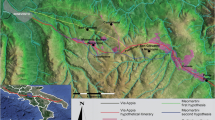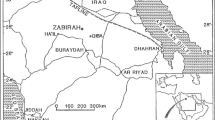Abstract
Talakadu is a well known historic place situated on bank of the river Cauvery in Mysore district of Karnataka. The place is close to concave side of a prominent meander where large amount of sand has accumulated. It is believed that after construction of a reservoir upstream, sand was exposed to wind action burying the structures of Ganga dynasty and other later kingdoms. A number of buried sites have been identified by archaeological excavations conducted so far. Presently the area forms sand dunes with thick plantation cover. Analysis of RADAR data (fine beam RADARSAT and ENVISAT ASAR) led to identifying a hitherto unknown buried channel through the Old Talakadu town adjoining the excavated archaeological sites. The study suggests that RADAR penetration through the plantation canopy seems to have occurred as observed by comparing with corresponding optical data of LISS-IV. Below the canopy, sand and shrubs on top of the channel (topographically low area) are acting as smooth surface providing dark tone on radar imagery. During field validation GPS was extensively used to navigate through the forest canopy and locate the buried channel, excavated archaeological sites as well as other anomalous patterns. Synergistic application of optical (RESOURCESAT-1 LISS-IV and CARTOSAT-1 & 2) and radar (fine beam RADARSAT and ENVISAT ASAR) data led to identifying remote sensing based guides for archaeological exploration. Integration of known archaeological sites with the identified anomalous patterns was done in GIS environment. This study adds on to the knowledge base of the site and compliments already known information and suggested new areas for further archaeological exploration.







Similar content being viewed by others
References
Berlin, G. L., Tarabzouni, M. A., Al-Nasser, A., Sheikho, K. M., & Larson, R. W. (1986). SIR-B subsurface imaging of a sand buried landscape: Al Labbah Plateau, Saudi Arabia. IEEE Trans. Geoscience and Remote Sensing, GE-24, 595–602.
Blom, R. G., Crippen, R. E., & Elachi, C. (1984). Detection of subsurface features in SEASAT radar images of means valley, Mojave Desert, California. Geology, 12, 346–349.
Devaraj, D. V., Narasinha Murthy, A. V., Krishna Murthy, M. S., & Swamy (1996). Excavations at Talakad, Directorate of Archaeology and Museums, Mysore.
McCauley, J. F., Schaber, G. G., Breed, C. S., Grolier, M. J., Haynes, C. V., Issawi, B., et al. (1982). Subsurface valley and geoarchaeology of Eastern Sahara revealed by shuttle radar. Science, 218, 1004–1019.
McCauley, J. F., Breed, C. S., Schaber, C. G., McHugh, W. P., Issawi, B., Haynes, C. V., et al. (1986). Palaeodrainages of the Eastern Sahara—the radar rivers revisited (SIR-A/B implications for a mid-tertiary trans-african drainage system). IEEE Trans. Geoscience and Remote Sensing, GE-24, 624–648.
Mehta, N. S., Rajawat, A. S., Bahuguna, I. M., Mehta, D. S., & Srimal, A. K. (1993). Geological potential of ERS-1 SAR data: Observations in parts of Aravalli and Thar desert (Western India). Proc. Second ERS-1 Symp.—Space at the Service of our Environment, Hamburg, Germany, 11–14 Oct., 1993, ESA SP-361: 931–936.
Mehta, N. S., Rajawat, A. S., Bahuguna, I. M., Mehta, D. S., Bhatnagar, P., & Srimal, A. K. (1994). Remote sensing for mineral exploration: Geological potential of ERS-1 SAR data covering parts of Aravalli hills and Thar desert (Rajasthan, India); Project Report, Space Applications Centre, Ahmedabad, SAC/RSA/RSAG/ERS-1/GEO/PR/01/94, 67 p.
Narasimhachar, L. (1950). A guide to Talakad, Government of Mysore, pp. 1–20.
Rajani, M. B., & Patra, S. K. (2009). Application of satellite image processing techniques for Talakadu, a unique archaeological landscape in India. Photo-Interpretation, ESKA, Paris, France, 2009–4, Vol 45, pp 168–175.
Rajani, M. B., Rajawat, A. S., Krishna Murthy, M. S., Kamini, J., Rao, & Srinivas (2008). Archaeological exploration in the Talakadu region along the bank of the Cauveri river, Karnataka, Southern India using multi-sensor satellite data and Geographic Information System (GIS). In R. Lasaponara & N. Masini (Eds.), Proceedings of Workshop on “Advances in Remote Sensing for Archaeology and Cultural Heritage Management”.
Rajawat, A. S., Narain, A., Navalgund, R. R., Pathak, S., Sharma, J. R., Soni, V., et al. (1999). Potentials of radar (ERS-1/2 SAR) and high resolution IRS-1C data in reconstructing palaeodrainage Network of Western Rajasthan, Memoir Geological Society of India, No. 42, 1999, Bangalore, pp. 245–258.
Srikantia, S. V., & Anantharamu, T. R. (1997). The Talkad sand dunes in Mysore district of Karnataka – their description, evolution and origin. Geological Society of India, 50, 315–321.
Acknowledgements
The authors are thankful to Dr. K. Kasturirangan, Former Director, National Institute of Advanced Studies (NIAS), Bangalore and Dr. R.R. Navalgund, Director, Space Applications Centre (SAC) for their overall guidance, Institutional support and encouragement in carrying out the present study. We are also thankful to Prof. B.V. Sreekantan, Prof. M.S. Krishnamurthy at NIAS and Dr. V. Raghavswamy at National Remote Sensing Centre (NRSC) for useful discussions. We are thankful to Dr. J.S. Parihar, Dr. Ajai and Dr. T.J. Majumdar at SAC for encouragement and support provided during the present study. We thank Dr. R. Gopal, Director and Dr. Gangadhar, Deputy Director, Directorate of Archaeology and Museums, Govt. of Karnataka, for guidance and support during field visits. The financial support to carry out this research was provided by RESPOND scheme, Department of Space, Government of India.
Author information
Authors and Affiliations
Corresponding author
About this article
Cite this article
Rajani, M.B., Bhattacharya, S. & Rajawat, A.S. Synergistic Application of Optical and Radar Data for Archaeological Exploration in the Talakadu Region, Karnataka. J Indian Soc Remote Sens 39, 519–527 (2011). https://doi.org/10.1007/s12524-011-0102-6
Received:
Accepted:
Published:
Issue Date:
DOI: https://doi.org/10.1007/s12524-011-0102-6




